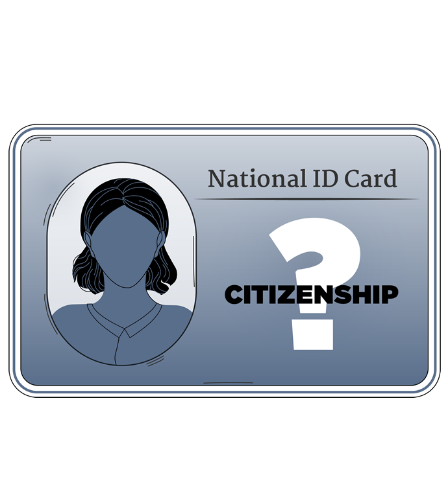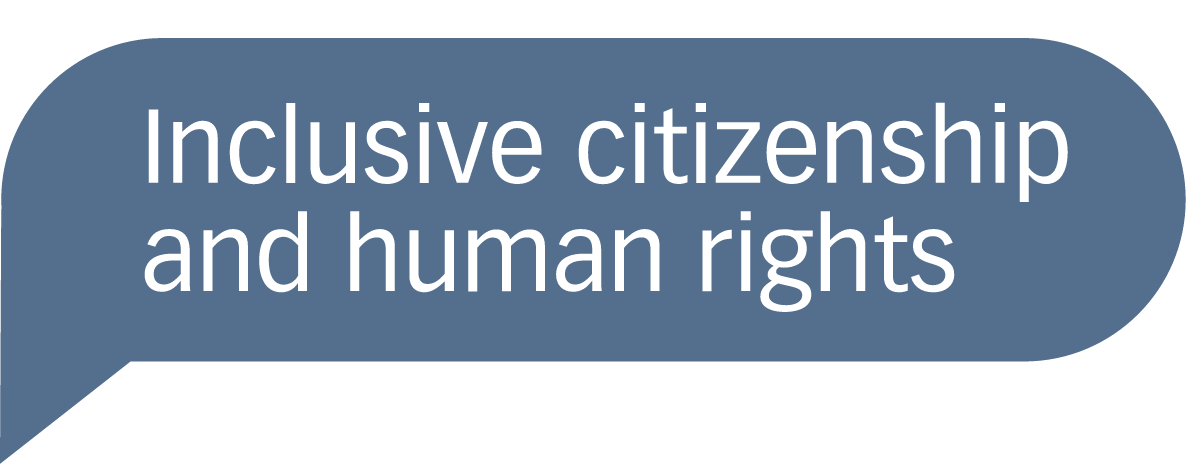Course: Citizenship and National Identity
Module 1: Citizenship and National Identity
This module explores the links between citizenship, national identity, and religion in shaping belonging and participation.

This module provides an understanding of citizenship and national identity, tracing their historical development and interconnections. It particularly explores the role of religion and ethnicity in shaping national identity and defining citizenship.
Defining Citizenship
Citizenship refers to the formal relationship between an individual and a state, entailing rights and responsibilities. However, it extends beyond legal definitions to explore how it shapes concepts of belonging, exclusion.
Nationality is a legal bond having as its basis a social fact of attachment, a genuine connection of existence, interest and sentiments, together with the existence of reciprocal rights and duties.
There is often confusion about whether citizenship and nationality are the same and what each term entails.
From an international legal perspective, Alice Edwards identifies two main approaches to understanding these concepts. The first approach sees nationality and citizenship as distinct yet interconnected aspects of state membership. Nationality is defined as the legal bond between an individual and a state, determining their status under international law. Citizenship, in contrast, represents the highest political rights and duties within municipal law. The second approach considers the two terms interchangeable, given their close relationship in terms of rights (see Module 2) and their similar purpose in both international and domestic legal contexts.
From a sociological standpoint, nationality and citizenship are seen as distinct concepts. Nationality is understood as a “collective identity that the people of the nation acquire by identifying with the nation”. It has a broader scope, encompassing aspects such as origin, ethnicity, and social affiliation, factors that citizenship is often not influenced by. However, within a nation-state, certain groups or individuals may not identify with the dominant national identity. While such non-nationals are not inherently citizens, they may acquire citizenship through cultural assimilation, sometimes requiring them to adapt or modify aspects of their original identity. In such cases, citizenship offers at least some level of support and inclusion for non-nationals due to its foundational principle of equality.
This course will use the terms ‘citizenship’ and ‘nationality’ interchangeably, from a rights-based perspective.
Religion and National Identity
Religion and ethnicity has often played a central role in shaping national identities, influencing language, customs, and laws. While secularization theory may have predicted a decline in religion’s role in public life, that is far from being the case at present. Ethnicity and religion continues to play an important role in shaping national identity, and in diverse societies, it can lead to divisions within society as different ethnic and religious groups navigate their place within national narratives. This dynamic can either foster pluralism and coexistence or fuel tensions over belonging and identity.
Ethno-nationalism is a form of nationalism that constructs national identity around shared ethnic, cultural, linguistic, or racial traits rather than civic or territorial affiliation. The 2018 Report (A/HRC/38/52) examines racial discrimination in the context of nationality, and immigration. It underscores that one of the most evident drivers of such discrimination in citizenship and immigration laws is explicit prejudice, often rooted in ethno-nationalist ideologies.
Identity politics in Myanmar, where the ethnic and religious identity of many minority communities, is frequently contested. For example, the Rohingya, a Muslim minority in Myanmar’s Rakhine State bordering Bangladesh, trace their roots there to the 8th century. However, Myanmar authorities view them as descendants of Bengali migrants from the British colonial era and deny their distinct identity, labeling them “Bengalis” to imply illegal origins. By the 1960s, this narrative of “illegal immigrants” had taken hold, reinforcing efforts to protect “national races” and expel alleged illegal immigrants.
Ethno-nationalism has played a critical role in shaping the political landscapes of Myanmar, driven by concerns over cultural preservation, demographic changes, and sovereignty. However, these complex discourses invite critical reflection on the criteria and limits through which belonging to a nation-state is defined and assessed.
Narrative approach: Exploring Majority & Minority Relations
It seems to be a part of human identity-building at many social levels and in various contexts to create stories about who “we” and “they” are. Such narratives are often based on religious, ethnic, social, national, or other divides. These narratives may be inclusive or exclusive, positive or negative.
For instance, minority groups may face exclusion, discrimination, and human rights violations, along with hate narratives that target them based on their religious beliefs, nationalities, and gender identities, when a State recognizes the majority’s ethnic and religious identity in a diverse country. These discourses frequently use metaphors, comparisons, and symbols designed to dehumanize or stigmatize particular groups. This majority-minority conflict can also impact minority nationality, as the majority rejects their identity within the national narrative.
One strategy to counter such rhetoric is through counter-narratives. This approach involves presenting stories and messages that directly challenge stereotypes by offering alternative perspectives and promoting inclusion. Hate narratives can be a key driver of group hostility, shaping perceptions and influencing exclusionary attitudes. Understanding these narratives provides insight into how prejudice manifests across different groups, from racial to religious communities.
Read more on the application of the Narrative approach in inclusive citizenship education.
State Sovereignty and Human Rights
State sovereignty guarantees exclusive authority to enact laws within the borders of the state. However, national legislation may be contrary to international obligations. Universal human rights standards require states to uphold fundamental rights, including the right to nationality and the protection of minorities (see Module 2).
The Treaty or Peace of Westphalia (1648) recognized the equality of states and the exclusive right of each state to control its own territory and enact domestic policies, free from external interference by other states. This became the cornerstone of public international law for decades to come. However, two brutal world wars and land conflicts led to the emergence of international human rights law in the 20th century. Human rights came to be recognized as inalienable and inherent to all individuals. This meant that states’ actions now had to be balanced with their obligation to uphold the human rights framework.
The International Human Rights Law (IHRL) framework developed as a legal regime after World War II to protect the inherent rights of individuals against abusive and arbitrary power, primarily exercised by the state. The IHRL framework comprises a range of treaties, conventions, declarations, and customary law designed to safeguard individual dignity and freedoms. Key instruments include the Universal Declaration of Human Rights (1948), which sets a global standard, and treaties such as the International Covenant on Civil and Political Rights (1966) and the International Covenant on Economic, Social and Cultural Rights (1966).
A central principle that runs through this body of law is non-discrimination, which requires states to treat all individuals equally. By ratifying such international instruments, states voluntarily limit aspects of their sovereignty and align domestic laws with international obligations. However, states also reserve the right to make reservations to certain provisions within international instruments, thereby allowing national policies to override specific norms.
Striking a balance between these often conflicting frameworks is a complex and contested undertaking. While the international legal framework is well-established, its practical implementation depends on the effectiveness of international oversight mechanisms, which, often, fall short of holding states accountable. Certain states hold more power than others in the international arena, which also influences and reshapes the development of the international legal order.
Oversight bodies such as the United Nations Human Rights Council, courts such as the ICJ and ICC, ad hoc tribunals, and various regional courts, including the Inter-American Court of Human Rights, the European Court of Human Rights, and the African Court on Human and Peoples’ Rights, monitor the actions of states and individuals. However, these bodies often lack the capacity and mandate for direct enforcement of their norms and must rely largely on international pressure and diplomacy. Additionally, varying state interpretations of certain norms often lead to the prioritization of national policies over international standards.
For example, the treatment of migrants and refugees has become a particularly contentious area in the relationship between states and the IHRL framework. The absolute character of the principle of non-refoulement under international instruments such as the Convention Against Torture prohibits states from returning individuals to countries where they face a real risk of torture or other forms of ill-treatment. This directly limits sovereign control over immigration policy. Nevertheless, many states continue to deport or ‘push back’ individuals, even at the risk of persecution or statelessness.
The past 80 years have seen significant developments in the field of IHRL. The individual rights have increasingly taken precedence over traditional conceptions of the state and the power it wields. While many challenges remain and continue to be addressed through advocacy and negotiation, the second half of the 20th century marked a decisive shift away from the idea that states possess unlimited sovereignty.
Key Case Presentations
Mass deprivation of nationality or denationalization is not a new phenomenon that we see in the 21st century. For example, in the 20th century, denationalization of Jewish people by Nazi Germany, denationalization of Kurdish people in Syria and Iraq, etc. We have also seen deprivation of nationality of Dominicans of Haitian descent in the Dominican Republic.
For the purpose of this course, we will examine the denial of nationality of Rohingya and the situation of other ethnic and religious minorities in Myanmar. The course analyzes how legal frameworks, political dynamics, and historical narratives intersect to shape practices of belonging and exclusion. Key cases in this course illustrate how state-led processes of exclusion can contribute to systemic marginalization of ethnic and religious minorities.
Myanmar’s Citizenship & Ethnicity
The 2008 Constitution of Myanmar, created under a military-dominated government, reflects a national vision shaped by ethnicity and religion. It gives special status and privileges to 135 ethnic groups that are officially recognized and fall into eight broad categories. Communities not included on the list, such as the Rohingya, Indian and Chinese descent are denied legal recognition and full citizenship. Other ethnic groups that may be included within the 135 ethnic groups, such as the Kachin, Chin, Karen have continued to experience marginalization and discrimination. Decades of marginalization, exclusion, and violence have been intensified by this ethnic- based system and national political practice.
Citizenship in Myanmar is linked to ethnic ancestry and ancestral residency before 1823, the start of British colonization according to the 1982 Citizenship Law. The law creates a structured hierarchy of membership by establishing three levels of citizenship: full, associate, and naturalized. The 2008 Constitution reinforces this system, where ethnic identity determines one’s legal status, rights, and political participation.
Marginalization of ethnic and religious minorities in Myanmar
In addition to the official classification of national races, the process of ‘Burmanisation’ has also contributed to the exclusion of certain groups in Myanmar. Being listed as a national race is not sufficient; an ethnic community must also prove its originality as Burmese, which ultimately prioritizes cultural identities associated with Buddhism and the Burmese language.
Myanmar’s National ID cards therefore include information on both ethnic identity, such as Bamar, Karen, Shan, or Mon, and religious identity, such as Buddhist, Christian, or Muslim. To prove ethnic identity, individuals are required to submit ancestral identity documents, a family tree, and household registration records. This process, combined with the disclosure of religious identity, often results in the exclusion of religious minorities within specific ethnic groups.
The Karen community, for example, with its distinct languages, traditions, and cultural practices from the dominant Bamar or Shan communities, is often denied identity documentation due to difficulties in proving ancestral origin. Karens following Christianity and Islam face additional barriers because of their religious affiliation. Newborns are sometimes denied birth certificates, as their parents must present identity documents verifying Burmese origin.
Read more here on the persecution against ethnic and religious minorities in Myanmar.
Denial of Citizenship of Rohingyas in Myanmar
The Rohingya Muslims are religious and ethnic minority from Rakhine State. The Rohingyas are denied citizenship and remain one of the largest stateless populations in the world.
Despite their long history of habitual residence in the area, the Myanmar government does not recognize them as one of the official “national races”. This community has faced systemic marginalization and state-led discrimination since the 1960s, escalating into widespread violence and mass displacement in subsequent decades.
In 2016 and 2017, violence against the Rohingyas intensified after attacks by a small Rohingya insurgent group. In response, the Myanmar military launched a brutal crackdown involving mass killings, sexual violence, and the destruction of villages. Following this wave of violence, over one million Rohingyas live in Cox’s Bazar refugee camp in Bangladesh, the largest refugee settlement in the world. Today, the Rohingyas remain one of the most persecuted minorities globally, deprived of basic rights and caught in a recurring cycle of statelessness, forced displacement, and persistent discrimination—both within Myanmar and beyond its borders.
Additional Resources
- Lachmann R . Nation-State Formation: Power and Culture. In: Janoski T, de Leon C, Misra J, Martin IW, eds. The New Handbook of Political Sociology. Cambridge University Press; 2020:458-483.
- Storm, H. J. (2022). The rise of the nation‐state during the Age of Revolution: revisiting the debate on the roots of nations and nationalism. Nations And Nationalism, 28(4), 1137-1151. doi:10.1111/nana.12857 https://scholarlypublications.universiteitleiden.nl/handle/1887/3443699
- Anderson, Benedict. 2016. Imagined Communities. London, England: Verso Books.
- Shady, S. N. (2021). Territory and the divine: the intersection of religion and national identity. West European Politics, 45(4), 744–766.
- Reynolds, S. G. (2019). National Identity and Religion: an unhealthy mix? The Furrow, 70(4), 241–244. http://www.jstor.org/stable/45210217
- Allen Buchanan and Margaret Moore (eds) (2003), States, Nations, and Borders: the Ethics of Making Boundaries” Link
- Gopal Krishna Siwakoti (2012) “Beyond Borders”
- Benedict Anderson, Imagined communities
- Edwards, Alice. 2014. “The Meaning of Nationality in International Law in an Era of Human Rights.” In Nationality and Statelessness under International Law, edited by Alice Edwards, and Laura Van Waas, 11–43. Cambridge: Cambridge University Press. https://doi.org/10.1017/CBO9781139506007.002.
- Oommen, T. K. 1997. Citizenship, Nationality, and Ethnicity: Reconciling Competing Identities. Cambridge, Mass: Polity Press.
- Spinner-Halev, Jeff. 1994. The Boundaries of Citizenship: Race, Ethnicity, and Nationality in the Liberal State. Baltimore: Johns Hopkins University Press.
- Antara Dalla, Refugees and Borders i11 South Asia: The Great Exodus of 1971 (Chapter 3), Routledge (2023)
- Mukherjee, Kunal. 2019. “The Ethnic Minority Question and Rohingya Crisis in Contemporary Myanmar.” Journal of Muslim Minority Affairs 39 (1): 26–43. https://doi.org/10.1080/13602004.2019.1575021.
- Topich, William J., and Keith A. Leitich. 2013. The History of Myanmar. The Greenwood Histories of the Modern Nations. Santa Barbara, Calif: Greenwood.
- International Crisis Group, Identity Crisis: Ethnicity and Conflict in Myanmar, 2020, https://www.crisisgroup.org/asia-pacific/myanmar/312-identity-crisis-ethnicity-and-conflict-myanmar
- UN Human Rights Council, Report of the detailed findings of the Independent International Fact-Finding Mission on Myanmar, 17 September 2018, A/HRC/39/CRP.2, available at: https://undocs.org/A/HRC/39/CRP.2
Questions for reflection and discussion
- Are there noticeable changes in the way citizenship and national belonging are described in your country? Do you see religion or ethnicity influencing these discussions?
- What similarities and differences do you see between the experiences of the Karen minorities and the Rohingyas in Myanmar when it comes to questions of belonging and citizenship?
- Taking into consideration the cases discussed here, do you think it is possible for a country to protect its sovereignty while still upholding human rights? If so, how can this be achieved?



